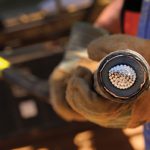It’s remarkable how tools and equipment can suddenly grow legs and walk off a wind farm or jobsite. A lost or missing tool may not seem like all that big of a deal, or a lot of money for that matter. But when a jobsite starts losing multiple tools, the replacement costs—not to mention the lost productivity—can quickly add up.
Tool manufacturers are leading the charge to help eliminate the growth of those legs and keep tools and equipment on the jobsite where they belong. A comprehensive tool management system includes organization, visibility, security, trackability, and accountability. Different applications and needs require different answers, from very low-tech solutions such as foam cutouts to visually identify if a tool is missing all the way to digital imaging software to track tool movement in real time. When implemented correctly, these jobsite tool management strategies provide an effective way to reduce tool loss, improve worker productivity, and ultimately save money. Figure 1
Low-Tech Solutions
Certainly the idea of using foam cutouts in a tool box as a way to visually inspect for any missing tools isn’t a new concept, but it is effective. Imagine trying to find a 19mm socket in a box in which tools are scattered throughout several drawers with no semblance of order. You may eventually locate the socket, but it could take awhile. A box with no organization also poses an inviting target to someone looking to take a tool home. Who’s going to know if that 19mm socket is missing from a box with tools that’s an unorganized mess? If the socket has been removed, and the next person is hunting through the box looking for it, the time wasted searching for it is keeping him from performing his job. That’s lost productivity.
Boxes with foam do provide an extra layer of security in preventing tool loss. A person is going to think twice before considering taking a tool home knowing that an empty foam cutout is showing the evidence of a missing tool. Foam also aids in alerting someone of a tool left behind on the jobsite. A quick scan of the drawers can reveal any missing tools that may have been inadvertently left behind on the job, which can then be retrieved. Figure 2
While using foam is a low-tech solution for tool control, the process of foam creation has come a long way from the days of tracing and cutting by hand. Some manufacturers cut foam to their customers’ exact specifications. One way to do this is for customers to lay out tools in a mock drawer with a camera positioned over it. The drawer is pre-sized to fit their existing tool boxes. They then arrange tools in the mock drawer to their liking, and take a photo of the layout. The process is repeated for each drawer. Once the photos are taken, they are sent to the manufacturer, where the photos are converted to a CAD drawing and fed into a CNC cut machine, and cut to the exact layout of the tools in the pictures. The foam drawers are ready to use and are cut precisely to fit their existing tools.
Another low-tech solution to tool control is using pre-made tool kits on the job site. Again, the concept of creating a kit for a specific job is nothing new, but what is different is the ability to add tool control to that kit to help ensure each tool is returned following the job.
Many companies that have created kits often include all the necessary tools to accomplish a task, but they are thrown into a bag or pouch and distributed to the technician at the tool crib. These tools can mistakenly get left behind because there’s no way of truly knowing if all the tools are in the pouch unless they’re counted. This is an inefficient process that may be skipped on the jobsite.
The better solution is a mobile mini tool chest that offers tool control. These types of boxes can be kitted to contain tools to perform specific maintenance out on a jobsite, but have drawers with foam for tool control. They’re designed with different configurations to meet different applications: two two-inch drawers plus six one-inch drawers, or three two-inch drawers plus four one-inch drawers. The drawers can be opened without having to flip the box over on its side. Figure 3
The box has wheels so it can be pulled by hand, and the drawers open and close on slides and rails and can be fully secured when not in use. Portable tool chests are ideal for applications where maintenance is being performed on more remote jobsites away from the tool crib.
Another was to prevent tool loss is simply through color. While shiny chrome tools can pose an attractive target to someone with sticky fingers, tools are available in a dull, black finish. It’s not to say that black-colored tools don’t walk away from tool boxes as well, it’s just another way for companies to reduce the appeal of tool theft.
High-Tech Solutions
Technology has greatly improved tool control to the point where a supervisor, miles from a jobsite, can track which tools are being used, and who is using them. For many tool boxes, keys are becoming a thing of the past. Tool boxes today can be accessed by someone using a badge with a bar code. Not only can a box be set up to allow specific people to access it, but there is now an electronic paper trail of a date stamp of when the box was accessed. This way, any lost or missing tools can be traced back to the person that last accessed them. Using an electronic badge to access tools does cut down on tool theft as boxes are more secure; only those persons authorized to use the box have access to it.
Beyond bar-code entry, software is now available to fully track which tools have been removed and returned to a box using a scanner. Here’s how it works: Once a person scans their credentials to gain access to the box, any tools removed are scanned by a handheld device that captures pertinent information about that tool. For instances where multiple people are accessing the same box, any tools removed are tagged to that specific individual. Tools and equipment can be marked for single use or in quantity. For example, if a kit has been developed containing 20 tools, it can be scanned as one item to save time. All returning tools are scanned to ensure full accountability. Figure 4
The latest adaptation of this type of technology is the use of digital imaging to track and monitor tools. Digital imaging removes the need to manually scan tools as cameras mounted inside the tool box scans the drawers each time the box is accessed, recording the removal and return of tools. Additionally, software keeps track of information and can transmit data via wireless or a cable Ethernet connection to a computer for further accountability.
These tool boxes, which can hold up to 750 tools, come equipped with an LCD monitor attached to the top to give technicians a visual view of the tool activity he is using from the box. Each time a drawer is open and tools are removed, the system scans the drawer and documents which tools have been removed. The box is also voice activated and announces which tools have been removed. When tools are returned, the system scans the opened drawer again and checks off which ones have been returned and both visually and audibly alerts the technician on the status of each tool. If a tool has been placed in the wrong foam cutout in the drawer, the voice alerts the technician to the discrepancy. Figure 5
The system, along with its tracking software, can also monitor calibration cycles of tools such as torque wrenches. Another benefit of this type of box is that it reduces the need for tool crib attendants during late-night shifts when maintenance needs to be performed but an attendant may not be available. Essentially the box acts as its own tool crib as multiple users can be set up to access the box with each user’s actions being tracked.
These more high-tech technologies are useful in those industries such as wind, natural resources, and aerospace where tool control is a prime concern. Leaving a tool behind in a wind tower could pose a threat to the operation of the turbine, not to mention the time wasted to go and recover the missing tool. Monitoring tools saves money and improves efficiencies.
Mobile Tool Crib
For some applications in the wind industry where it may be more advantageous to bring the crib and its tool control directly to the jobsite, a mobile tool crib may be the answer. A mobile tool crib can be preloaded with thousands of tools and shipped directly to a remote job site and be fully operational in just a few days. When the job is finished, the crib can be loaded onto a tractor trailer and moved to the next site. This cost-saving move reduces tool costs by bringing the tools to the workers when needed.
Mobile tool cribs, which can be staffed with an attendant from a tool manufacturer, offers the same level of tool control and accountability as the technology found in individual boxes. These cribs are designed to be quickly deployed to remote locations and put tools into the hands of workers on a jobsite, yet at the same time using tool control technology to eliminate lost tools and save money.
When a new mobile tool crib is set up on a jobsite, the first thing the attendant accomplishes is entering each worker into the tool tracking software and assigning each of them a bar code. A quick scan of the employee’s barcode, followed by a scan of the tool accurately tracks the equipment that has left the crib and who’s responsible for it. This setup can be done by a designated employee, or some suppliers will even provide a trained tool crib attendant to manage the mobile tool crib onsite. Modular in design, mobile tool cribs range between 20 and 40 feet in length, include storage and control systems, cabinets, and shelving, plus electrical components that include lighting, air conditioning, and electronic entry systems. A mobile tool crib isn’t the answer for every application, but for those companies operating multiple jobsites it can become an efficient, cost-saving tactic to supplying and tracking tools for workers.
As systems and components become more complex, tooling will need to keep pace by providing the right solutions for technicians to get the job done correctly. That’s why it’s becoming more important to control those tools and keep them on the jobsite ready for use. There are several ways companies can go about implementing a tool control program. Consulting with a tool manufacturer to review your application, needs, and expectations is the best way to proceed in obtaining a tool control program that will provide the best return on your investment.








































